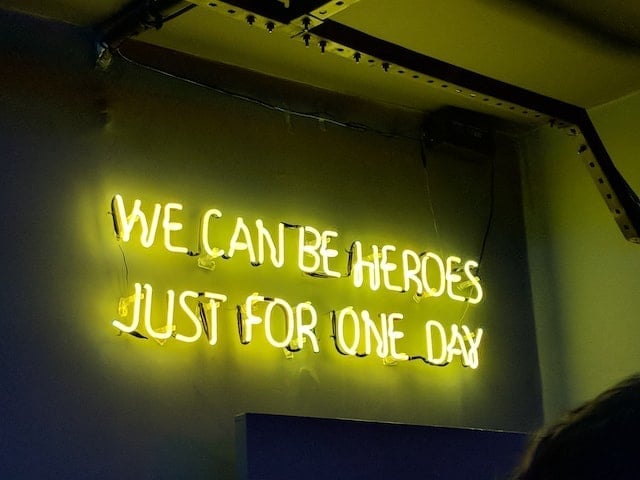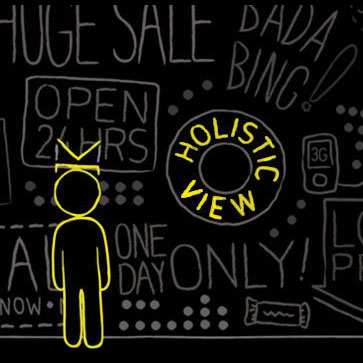How Tra-Digital Advertising is the Future of All Marketing

The traditional advertising realm was fundamentally altered when the boom of digital advertising came about in the early 2000's.
It shook the fabric of the status quo and literally split the marketing world into two different but equally important segments. Over the course of the last 15 years, traditional agencies have always struggled grasping and delivering high-quality digital campaigns. Inversely, digital agencies have had an equally difficult time breaking into the traditional world. This unfortunate trend has been at the expense of the consumer, until now.
Understanding who we are marketing to
It is important to understand how media is being consumed across all generations in the United States in order to fully grasp the power behind tra-digital advertising. After all, what we do as marketers is analyze and understand "markets" or better said, people. Getting into the psychology of our consumers is paramount in effective marketing. Without a shadow of a doubt, how consumers purchase, consume and interact with brands has evolved since the emergence of the Internet but traditional advertising isn't shrinking. In fact, digital and traditional mediums are projected to increase over the next four years according to PwC's global entertainment and media outlook report: 2016-2020.
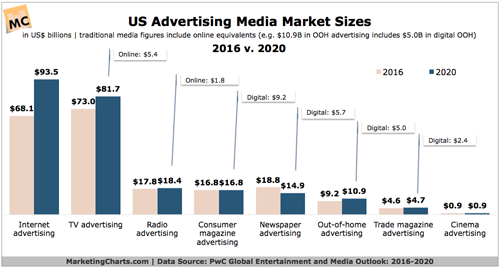
Back in 2014 a study found the prolific exposure each generation with buying power has with traditional and digital mediums. The silent generation, which is 70-plus, is the only generation that consumes predominately more traditional media than digital. However, they still consume a large amount of digital. What is interesting is that ages 18-69 consume almost an even amount of digital versus traditional media. You can obviously see how a standalone traditional only or digital only campaign is missing out on an enormous opportunity, right?
For the first time in human history, we now have a new generation of young adults who have purely been raised "online." The millennial generation alone has recently surpassed the size of the baby boomer generation according to a recent study by Pew Research, producing more savvy Internet users than every before. How they are consuming media and interacting with brands gives us a glimpse into the future of advertising as a society. Therefore, understanding this audience will give us some context to where all marketing is headed.
To go further down the funnel, Google recently released what they call micro-moments. The belief that in people's everyday life, there are micro-moments where they turn to Google for an answer/solution to their problem. Typically, people turn to mobile devices in these micro-moments but that power to capture micro-moments can be heavily influenced by traditional media. Building campaigns to be optimized for these micro-moments is the future of marketing. I will show you how.
Important takeaways are:
- Increase use in smartphone devices across all generations
- Digital mediums are prolific among all generations
- Traditional mediums are prolific among all generations
- Capturing people during micro-moments is your best chance at a conversion
How to start tracking your traditional media
John Wanamaker coined the phrase "Half the money I spend on advertising is wasted; the trouble is I don't know which half." In my 14 years of experience I have seen this first hand to be true when it comes to traditional media. This is one of the major failures that exist in the traditional marketing world and has for a very long time. Major brands may be used to buying traditional media this way but many small- and medium-sized businesses stay away from traditional media because they are afraid it is too expensive and won't generate the business they need. However, when properly integrated with digital tracking, you can begin to not just track but also optimize your traditional media in a cost effective way.
Let's recognize the elephant in the room for just a moment, there is no way to track 100 percent of all offline conversions, but if we can track a large portion of the conversions we can then attribute value to each channel and begin to optimize in. Below are some ways you can start tracking and optimizing your traditional media through digital means.
Call Tracking
Call tracking has been around for a very long time but predominantly used for digital campaigns. Setting up call tracking for all of your traditional media is by far the best way to track leads from traditional media. Putting a tracking number on your direct mail, OOH, TV commercials, radio spots, magazines, newspapers, etc., will allow you to start associating value to different traditional media channels.
Data Correlation
The second way we connect offline to online performance is through data correlation. This step is a bit more complicated and is for advanced marketers who have some coding and Excel abilities. We first start with configuring this Google script in the targeted AdWords account. This script is designed to automatically increase bids for desired search terms based on your TV/radio run times. You can expect to see an increase in search impression share and lead volume during these times when utilizing this tactic.
Our agency uses our own database where we store our clients' analytics data and we can query that data in order to correlate it quickly. If you do not have that capability, then correlating the data will be a manual process. You can start by running reports in AdWords based on time of day and include conversions. Simply dump that data into Excel and create a pivot table. You will be able to cross reference your run times with conversions to deduce what mediums and run spots work better than others.
PRO TIP: Make sure you are including any data that is outside of AdWords like call tracking data that's not tied back.
Important takeaways are:
- Using customized urls in traditional media can help with tracking
- Using call tracking can drastically improve conversion tracking on traditional media
- Correlating data helps tell the story of how your traditional media is performing
The results of a tra-digital campaign
Tra-digital advertising is not just a buzzword it's a way of thinking. Combining the power of both offline and online marketing exposes your brand to your target audience in a ubiquitous way. One client success story I will share with you is a local Jacuzzi dealer we work with. Selling jacuzzis is not an easy thing to do. They have a high price tag and it's not an impulse purchase, its much like selling a car, yet they are not necessary items for most people. They had tried paid search before with no luck and expressed concerns about engaging in traditional media. Their cost per lead was in the hundreds before we started working with them and they were not getting the quality leads they needed. We put together a comprehensive tra-digital campaign, which ended up delivering an explosion of leads and sales. Below you will see a screenshot from an events report in analytics that shows you some of the results we got after we launched this tra-digital campaign.
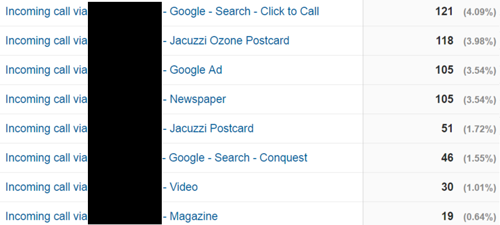
The total amount of phone calls came in at 595. We saw that 323 where from traditional media and only 272 came from digital media. Furthermore, we were able to see the quality of leads per channel by working with our client's customer relationship management (CRM) solution. This helped make the argument that traditional media was working well in tandem with our digital campaigns. Since we could track and correlate data correctly we were able to optimize our traditional media in order to put our client's money where they would receive the best results.
Tracking conversions for traditional media is great but it's only a part of the equation. The bigger picture is looking at things like direct traffic and branded search traffic as they correlate with your traditional media buys. Below is a graph correlating our Jacuzzi dealer client's traditional media spots with site traffic overlay.
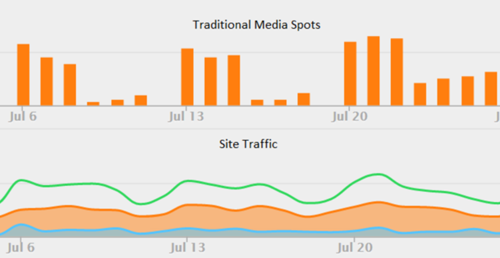
![]()
As you can see above, each time a new set of traditional media ad spots run there is a direct correlation between them and site traffic. There is also a correlation between branded searches and traditional media run times. By bidding on branded search terms while using our TV run time script we drastically reduced our cost per lead while increasing targeted, qualified leads. By integrating a tra-digital campaign we were able to more than double the amount of leads the client had been receiving.
The failure of digital and traditional media companies doesn't have to be your failure. Engaging in a tra-digital campaign can be done on almost any budget for any size client. The convergence of traditional and digital are here, are you taking advantage of it?






